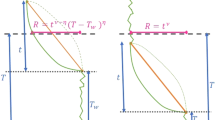Abstract
In this work, we set up the distribution function of \(\mathcal{M}:={\mathrm{sup}}_{n\ge 1}{\sum }_{i=1}^{n}\left({X}_{i}-1\right),\) where the random walk \({\sum }_{i=1}^{n}{X}_{i},n\in {\mathbb{N}},\) is generated by N periodically occurring distributions, and the integer-valued and nonnegative random variablesX1,X2, . . . are independent. The considered random walk generates a so-called multiseasonal discrete-time risk model, and a known distribution of random variable M enables us to calculate the ultimate time ruin or survival probability. Verifying obtained theoretical statements, we demonstrate several computational examples for survival probability P(M < u) when N = 2, 3, or 10.
Similar content being viewed by others
References
S. Asmussen and T. Rolski, Risk theory in a periodic environment: The Cramér–Lundberg approximation and Lundberg’s inequality, Math. Oper. Res., 19(2):410–433, 1994, https://doi.org/https://doi.org/10.1287/moor.19.2.410.
K. Blaževičius, E. Bieliauskienė, and J. Šiaulys, Finite-time ruin probability in the inhomogeneous claim case, Lith. Math. J., 50(3):260–270, 2010, https://doi.org/https://doi.org/10.1007/s10986-010-9084-2.
J. Damarackas and J. Šiaulys, Bi-seasonal discrete time risk model, Appl. Math. Comput., 247:930–940, 2014, https://doi.org/https://doi.org/10.1016/j.amc.2014.09.040.
F.E. De Vylder, La formule de Picard et Lefèvre pour la probabilité de ruine en temps fini, Bulletin Français d’Actuariat, 1(2):31–40, 1997.
F.E. De Vylder, Numerical finite-time ruin probabilities by the Picard–Lefèvre formula, Scand. Actuarial J., 1999(2): 97–105, 1999, https://doi.org/https://doi.org/10.1080/03461239950132598.
F. De Vylder and M.J. Goovaerts, Recursive calculation of finite-time ruin probabilities, Insur. Math. Econ., 7(1): 1–7, 1988, https://doi.org/https://doi.org/10.1016/0167-6687(88)90089-3.
D.C.E. Dickson, Insurance Risk and Ruin, Cambridge Univ. Press, Cambridge, 2005.
D.C.M. Dickson, On numerical evaluation of finite time survival probabilities, Br. Actuar. J., 5(3):575–584, 1999, https://doi.org/https://doi.org/10.1017/S135732170000057X.
D.C.M. Dickson and H.R.Waters, Recursive calculation of survival probabilities, ASTIN Bull., 21(2):199–221, 1991, https://doi.org/https://doi.org/10.2143/AST.21.2.2005364.
P. Erdős and S.J. Taylor, Some problems concerning the structure of random walk paths, Acta Math. Acad. Sci. Hung., 11(1):137–162, 1963, https://doi.org/https://doi.org/10.1007/BF02020631.
H.U. Gerber, Mathematical fun with ruin theory, Insur. Math. Econ., 7(1):15–23, 1988, https://doi.org/https://doi.org/10.1016/0167-6687(88)90091-1.
H.U. Gerber, Mathematical fun with the compound binomial process, ASTIN Bull., 18(2):161–168, 1988, https://doi.org/https://doi.org/10.2143/AST.18.2.2014949.
A. Grigutis and J. Jankauskas, On 2×2 determinants originating from survival probabilities in homogeneous discrete time risk model, Results Math., 77:204, 2022, https://doi.org/https://doi.org/10.1007/s00025-022-01736-y.
A. Grigutis, A. Korvel, and J. Šiaulys, Ruin probability in the three-seasonal discrete-time risk model, Mod. Stoch., Theory Appl., 2(4):421–441, 2015, https://doi.org/10.15559/15-VMSTA45.
P.K. Jordanova and M. Stehlík, On multivariate modifications of Cramer–Lundberg risk model with constant intensities, Stochastic Anal. Appl., 36(5):858–882, 2018, https://doi.org/https://doi.org/10.1080/07362994.2018.1471403.
D.G. Kendall, The genealogy of genealogy branching processes before (and after) 1873, Bull. Lond.Math. Soc., 7(3): 225–253, 1975, https://doi.org/https://doi.org/10.1112/blms/7.3.225.
Cl. Lefèvre and S. Loisel, On finite-time ruin probabilities for classical risk models, Scand. Actuar. J., 2008(1):41–60, 2008, https://doi.org/10.1080/03461230701766882.
Cl. Lefèvre and Ph. Picard, A nonhomogeneous risk model for insurance, Comput. Math. Appl., 51(2):325–334, 2006, https://doi.org/10.1016/j.camwa.2005.11.005.
S. Li, Y. Lu, and J. Garrido, A review of discrete-time risk models, RACSAM, Rev. R. Acad. Cienc. Exactas Fís. Nat., Ser. A Mat., 103(2):321–337, 2009, https://doi.org/10.1007/BF03191910.
F. Lundberg, I. Approximerad framställning af sannolikhetsfunktionen; II. Återförsäkring af kollektivrisker, PhD thesis, Uppsala University, 1903 (in Swedish).
V.Y. Pan, Howbad are Vandermonde matrices?, SIAM J.Matrix Anal. Appl., 37(2):676–694, 2016, https://doi.org/https://doi.org/10.1137/15M1030170.
K. Pearson, The problem of the random walk, Nature, 72:294, 1905, https://doi.org/https://doi.org/10.1038/072294b0.
Ph. Picard and Cl. Lefèvre, The probability of ruin in finite time with discrete claim size distribution, Scand. Actuar. J., 1997(1):58–69, 1997, https://doi.org/10.1080/03461238.1997.10413978.
Ph. Picard and Cl. Lefèvre, Probabilité de ruine éventuelle dans un modèle de risque à temps discret, J. Appl. Probab., 40(3):543–556, 2003, https://doi.org/10.1239/jap/1059060887.
L. Rincón and D.J. Santana, Ruin probability for finite negative binomial mixture claims via recurrence sequences, Commun. Stat., Theory Methods, 2022, https://doi.org/10.1080/03610926.2022.2087091.
S.M. Ross, A First Course in Probability, 8th ed., Prentice Hall, Upper Saddle River, NJ, 2010.
W. Rudin, Real and Complex Analysis, 3rd ed., McGraw-Hill, New York, 1987.
D.J. Santana and L. Rincón, Ruin probabilities as functions of the roots of a polynomial, Mod. Stoch., Theory Appl., 10(3):247–266, 2023, https://doi.org/10.15559/23-VMSTA226.
H. Sedrakyan and N. Sedrakyan, The Cauchy–Bunyakovsky–Schwarz inequality, in Algebraic Inequalities, Springer, Cham, 2018, pp. 45–57, https://doi.org/10.1007/978-3-319-77836-5_4.
E.S.W. Shiu, Calculation of the probability of eventual ruin by Beekman’s convolution series, Insur. Math. Econ., 7(1):41–47, 1988, https://doi.org/https://doi.org/10.1016/0167-6687(88)90095-9.
E.S.W. Shiu, The probability of eventual ruin in the compound binomial model, ASTIN Bull., 19(2):179–190, 1989, https://doi.org/https://doi.org/10.2143/AST.19.2.2014907.
E. Sparre Andersen, On the collective theory of risk in case of contagion between the claims, in Transactions of XVth International Congress of Actuaries, Vol. 2, Actuarial Society of America, New York, 1957, pp. 219–227.
M. Stehlík, Ch. Helperstorfer, P. Hermann, J. Šupina, L.M. Grilo, J.P. Maidana, F. Fuders, and S. Stehlíková, Financial and risk modelling with semicontinuous covariances, Inf. Sci., 394–395:246–272, 2017, https://doi.org/https://doi.org/10.1016/j.ins.2017.02.002.
I. Tishby, O. Biham, and E. Katzav, The distribution of first hitting times of random walks on directed Erdős–Rényi networks, J. Stat. Mech. Theory Exp., 2017(4):043402, 2017, https://doi.org/https://doi.org/10.1088/1742-5468/aa657e.
S. Wang and Y. Gao, Precise large deviations for aggregate claims of a compound renewal risk model with arbitrary dependence between claim sizes and waiting times, Lith. Math. J., 62(4):542–552, 2022, https://doi.org/https://doi.org/10.1007/s10986-022-09581-w.
H. Yang and L. Zhang, Ruin problems for a discrete time risk model with random interest rate, Math. Oper. Res., 63(2):287–299, 2006, https://doi.org/https://doi.org/10.1007/s00186-005-0025-5.
Y. Yang, X. Wang, and Z. Zhang, Finite-time ruin probability of a perturbed risk model with dependent main and delayed claims, Nonlinear Anal.Model. Control, 26(5):801–820, 2021, https://doi.org/10.15388/namc.2021.26.23963.
A. Zhang, S. Liu, and Y. Yang, Asymptotics for ultimate ruin probability in a by-claim risk model, Nonlinear Anal. Model. Control, 26(2):259–270, 2021, https://doi.org/10.15388/namc.2021.26.20948.
Mathematica 13.3,Wolfram Research, Champaign, IL, 2023, https://www.wolfram.com/mathematica.
Author information
Authors and Affiliations
Corresponding author
Additional information
Publisher's Note
Springer Nature remains neutral with regard to jurisdictional claims in published maps and institutional affiliations.
Rights and permissions
Springer Nature or its licensor (e.g. a society or other partner) holds exclusive rights to this article under a publishing agreement with the author(s) or other rightsholder(s); author self-archiving of the accepted manuscript version of this article is solely governed by the terms of such publishing agreement and applicable law.
About this article
Cite this article
Grigutis, A., Jankauskas, J. & Šiaulys, J. Multiseasonal discrete-time risk model revisited. Lith Math J 63, 466–486 (2023). https://doi.org/10.1007/s10986-023-09613-z
Received:
Revised:
Published:
Issue Date:
DOI: https://doi.org/10.1007/s10986-023-09613-z




